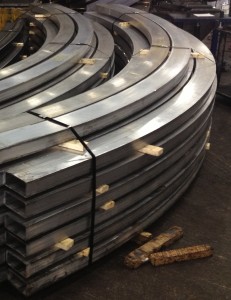Aluminum is often the material of choice by designers due to its high strength-to-weight ratio. It has great structural strength properties including toughness and hardness. It has good finishing characteristics; it is easily anodized in clear or many different colors. Aluminum offers good corrosion resistance and is easily welded. It also comes in many different shapes including flats, rounds, and structurals. But one thing that aluminum does not always offer is ease of workability, in particular forming/bending.
Aluminum 6061-T6 and 6063-T6 are the most common grades and tempers of aluminum specified. The T6 represents the materials temper and its degree of hardness. Its high strength-to-weight ratio often makes it the best choice for structural applications, but it also makes the material extremely hard and brittle and therefore not the easiest of materials to work with when it comes to bending.
Often bender/rollers may encounter material failure in the form of cracking when pressures are applied, or after the material has been worked past a certain degree. When asked about the failure of 1 1/2″ Aluminum 6061-T6 & 6063-T6 pipe when being bent, The Aluminum Association replied with, “For greater bendability, 6061-T4 or 6063-T4 pipes of the same size should be considered… After bending, the pipes can be strengthened by artificial aging.” In the most basic of terms, if you experience material failure at a T6, try a lower temper. If a lower temper isn’t available then the only thing left to do is to explore the option of heat treating in order to reduce the material’s hardness. This very thing was experienced when rectangular aluminum tubing was bent for the roof structure for a newly constructed NASCAR Carwash in Illinois.
52 pieces of 8″ x 4″ x 1/4″ Rectangular Aluminum 6061-T6 tubing was called to be bent to an 18′-0″ inside radius. This material is produced for structural applications and can’t be found in any temper other than T6. When pressures were applied, the material failed almost immediately. Material CERTS were pulled, and it was determined that the aluminum tubes were too hard and brittle, and in the current condition they were in, could not be successfully bent without the chance of failure in every one of the 52pcs. In order to bring the tubing into a condition where they could be worked without chance of failure, they were sent out to be heat treated in order to reduce the material’s hardness and bring it into a workable state. Once heat treated, all 52pcs of the aluminum rectangular tubing were successfully rolled to the specified inside radius of 18′-0″.








